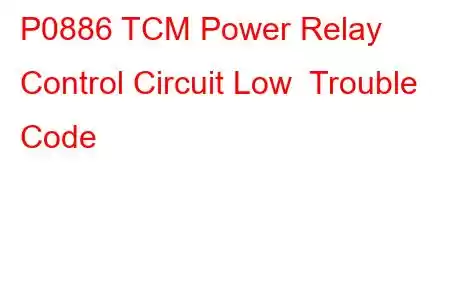P0886 TCM Power Relay Control Circuit Low
OBD-II Trouble Code Technical Description
TCM Power Relay Control Circuit Low
What does P0886 mean?
This diagnostic trouble code (DTC) is a generic powertrain code and applies to many OBD-II vehicles (1996-newer). That may include but is not limited to vehicles from Hyundai, Kia, Smart, Jeep, Dodge, Ford, Dodge, Chrysler, etc. Although generic, the exact repair steps may vary depending on year, make, model and powertrain configuration.
If your vehicle has stored a code P0886, accompanied by a malfunction indicator lamp (MIL), it means that the powertrain control module (PCM) has detected a low voltage condition in the TCM power relay control circuit.
While some transmission control modules (for OBD-II equipped vehicles) are integrated into the PCM, most are stand-alone components. TCM related codes are stored as P-codes, B-codes, or even U-codes, depending on vehicle make and model. If a P0886 code is stored, there is a good chance that there are other PCM and/or TCM codes stored as well.
The CAN is a complex system of wiring and connectors that is utilized to transmit data between the TCM and the PCM. Data (including stored codes) may also be shared with other controllers via the CAN. Transmission input and output speed (RPM), vehicle speed, and wheel speed are all shared between multiple controllers. This data is not only used for comparison in electronic traction control systems, but anti-lock braking systems and electronic stability control systems as well. This code is unique in that it is usually only stored if other traction control system related codes are present. These may be codes related to mechanical or electronic issues.
Electronic transmission control systems in OBD-II equipped vehicles are controlled using a network of computers (called control modules). This involves constant communication between the various control modules via the controller area network (CAN).
The PCM utilizes input signals from multiple engine and transmission sensors to calculate automatic transmission shift strategy. A high-pressure pump (inside the transmission) forces fluid through the valve body and into the sprag assembly; in addition to lubricating and cooling the transmission. The high-pressure fluid allows the clutches to separate from the sprag momentarily so that the gear ratio may be changed smoothly. One or more electronic pressure control (EPC) solenoids help to regulate fluid pressure. Electronic pressure (EP) sensors provide the PCM with pertinent data regarding fluid pressure at various points in the transmission. Electronic shift solenoids are used to interrupt the flow of high-pressure fluid so that the transmission shifts gears when commanded. The PCM uses voltage input signals from the transmission input speed sensor and transmission output speed sensor to determine if the transmission is shifting efficiently.
As with many other automatic transmission malfunctions, a transmission control system code may be caused by either an electrical or mechanical failure. If the PCM detects a malfunction which demands MIL illumination, a code P0886 will be stored and a MIL may be illuminated.
An example of a typical TCM transmission control module:
What is the severity of this DTC?
Battery voltage is supplied to the TCM using one (or more) fuses and/or contact relays. If the TCM or PCM detect insufficient voltage on the input supply (from the relay or fuse) a P0886 will be stored and a MIL illuminated.
If this code is stored, you may have noticed that your transmission shifts much more harshly than normal. If your vehicle has exhibited a code P0865, it should be diagnosed as soon as possible.
What are some of the symptoms of the code?
Symptoms of a P0886 trouble code may include:
Electronic traction control disabled Erratic transmission shift pRead: 21


